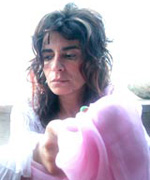WORLD & FOLK
Latin
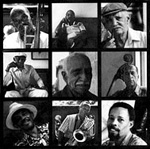 |
Des légendes vivantes telles que Rubén González au piano, Manuel "Puntillita" Licea au chant ou encore Felix Valoy, côtoient les jeunes phénomènes (Julienne Oviedo, 13 ans, aux timbales). En prime, Ry Cooder vient pointer de la slide-guitare sur un morceau. |
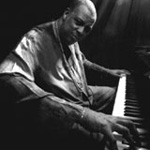 |
Chucho Valdes est le pianiste, compositeur, arrangeur, le plus renommé de Cuba. C'est aussi le chef de l'orchestre le plus expérimental de l'histoire du jazz cubain depuis la révolution : Irakere. Aussi connu pour ses solos à couper le souffle que pour sa fusion musicale unique, depuis plus de trente ans, seul ou en grande formation, live ou en studio, la musique de Chucho Valdes fait le bonheur des aficionados du monde entier. |
 |
Omar Sosa is an extraordinary person, in every sense of the word. A highly talented and intuitive pianist and composer, his finely tuned musical encounters between the Afro Cuban, jazz and urban Hip Hop scenes delight and fascinate. His untiring search for a musical language uniting the four corners of the globe has resulted in some of the most radically original and beautifully subtle musical productions released over the past few years. |
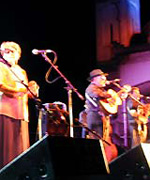 |
Des oncles musiciens, une mère chanteuse, et le padre Felix Valera Miranda au centre donne un groupe de son et de bolero traditionnels, pour lequel la musique est une activité naturelle. |
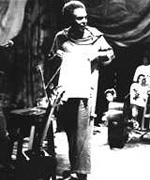 |
Gilberto Passos Gil Moreira was born on 26 June 1942 in Salvador de Bahia. His was a quiet childhood spent in the family's country house close to the city. The violeros' duels (musical contests) in the small village market of Ituaçu, the radio shows from Rio de Janeiro and a meeting with accordion player Cinézio would inspire the young Gilberto to become a musician. At the age of 10, he went back to Salvador to go to school and joined an accordion academy. He formed his first group "Os Desafinados" at the age of 18, in which he played both the accordion and the vibraphone. |
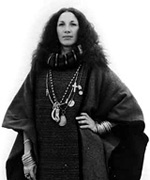 |
Brazil’s foremost jazz singer has been gracing stages worldwide for four decades with her singular six-octave vocals. Flora Purim’s career took off in 1967 when she moved from her native Rio to New York with her pygmalion husband Airto Moreira. She has since shown that she can shine as brilliantly as a solo artist. Collaborations with some of the top names in jazz continue into the 21st century as Purim remains a durable and endearing voice in world and jazz circles. |
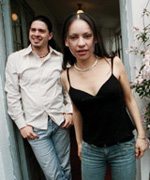 |
Impish Gabriela Quintero and roguish Rodrigo Sanchez have successfully made the transition from the heavy metal scene in Mexico City to the folk-rock-jazz world of Ireland. Their three acoustic CDs and live performances make them worthy inheritors of guitar wizards Paco de Lucia, Al di Meola and John McLaughlin. |
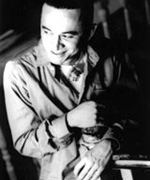 |
The press have nicknamed him the « salsero Don Quixote ». Buenaventura’s social and political engagement has been nourished by his difficult start in life... and music. Named after the Russian cosmonaut Yuri Gagarin, he grew up in a remote town of Colombia called… Buenaventura. After turning his back on economics studies in Paris he became a successful salsa crooner in the Latino Paris scene. A disastrous return to Colombia for a record project left him penniless. His interpretation of Jacques Brel’s classic “Ne me quitte pas” saved him, however, and Buenaventura became the first salsa singer in France to go gold. The singer has added three more albums to his repertory since that breakthrough. All testify to his audacious explorations of his Latin American heritage and its African roots. |
European
 |
"Attirail (noun): a collection of objects needed for a certain use". It is clearly not in the dictionary that a precise definition of L'Attirail may be found. In any case, does a definition even really exist ? L'Attirail's music is not the sort to be defined or categorised. L'Attirail's music is for listening to, living, dancing and more than likely drinking. Without forgetting travelling and partying. |
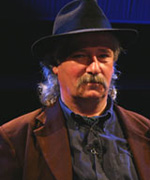 |
Erik Marchand has been travelling the colourful routes of world music for several decades now. The singer and clarinet player has done as much as anyone to popularise music from his native southern Brittany, in particular the gwerz. Born in Paris, Marchand settled in his parents’ province of origin in 1975 and plunged into the traditional gwerzioù chanting and a repertory that was on the verge of extinction. The creation of his Gwerz band in the early 80s signalled a revival that has shown no sign of abating. Yet his passion for music from other horizons has also led to some of France’s most innovative exchanges with world music. |
 |
Paris Combo is a colourful group made up of French, Australian and Madagscan musicians all with a common love for the repertoire of classic chanson française to which they irreverantly add pinches of gypsy jazz, Latin rhythms and Middle Eastern exoticism. |
 |
Born in the heart of France in 1957 Titi Robin has forged one of the most prolonged and exciting careers of crossover music in the Hexagon. The self-taught guitarist with a twitchy moustache and infectious laugh has left few repertoires in “world music” unexplored. But it is gipsy music that he sees as the inevitable bridge between the musical heritage in the East and Europe. Since the 80s Robin has enchanted audiences with his audacious marriages between Oriental and Andalusian cultures. |
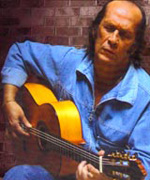 |
Guitariste hors du commun, alter ego de Camarón de la Isla. Il a révolutionné le Flamenco et s’est imposé comme le plus grand musicien espagnol de sa génération. |
 |
Mélange de sons orientales et d'influences antiques, l'Ham de Foc offre une musique méditéranéenne atemporelle. |
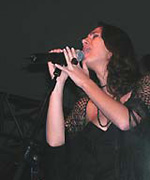 |
Née à Lisbonne, dans la grande lignée des chanteuses de fado, Ana Sofia Varela a joué avec de grands musiciens comme Madredeus et Camané. |
 |
Née en 1972 au Portugal, Cristina Branco chante le Fado avec un naturel et une simplicité bouleversante. Sa capacité à transmettre l'émotion est étonnante. Une immense artiste. |
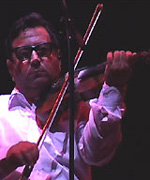 |
Composé des violonistes Urszui Kalman, Pusztai Aladar et du chanteur Vasile Soporan, cet ensemble interprète des chansons traditionnelles roumaines, hongroises et tsiganes. Signifiant littéralement « La Transylvanie », il a à sa tête Emil Mihaiu, l’un des meilleurs violonistes de cette région de Roumanie. |
 |
Napoléon et Nadia Constantin viennent de la plaine roumaine du Danube. Descendant de la tradition des montreur d’ours, Nadia danse devant son mari qui chante en frappant sur des percussions de fortune. |
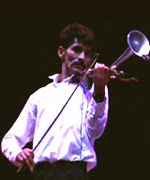 |
l joue d’un violon sans corps, affublé d’un pavillon, Jelu Covaci est un virtuose du violon trompette. Ce tsigane qui habite la région de Bihor en Roumanie a adopté cet instrument inventé en Angleterre, qu’il fait vivre aux sons de la tradition accompagné de tambour, accordéon ou encore orgue électronique |
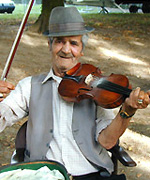 |
Avec leurs tronches hors du temps, leurs dégaines que l'on devine pleines d'histoires, le "Taraf de Haïdouks" est la formation la plus connue de musique tsigane roumaine. Une musique qui déborde de vie, de rires, de sanglots et de bagarres à coups de poing. De l'authentique, du "pas trafiqué" qui a superbement illustré le film "Latcho Drom". |
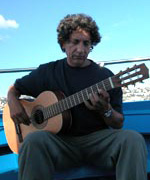 |
Figure de proue du renouveau des musiques populaires, il est celui que la presse napolitaine surnomme "L'âme du Sud". Compositeur, auteur, interprète, musicologue… Eugenio Bennato a donné ses lettres de noblesse à un style plébéien : la Tarentelle, qui est devenu un phénomène de société parmi les jeunes. Et la "Taranta Power" déferla sur le monde… |
 |
The lithe figure of Carmen Consoli has been a prominent feature of Italy’s folk, rock and « world music » scene for decades. She is considered one of the country’s most dextrous musicians, plunged into the traditional sounds of her native Sicily but equally at ease with rock, jazz, blues, bossa nova and folk. The rich texture of her voice gives life to songs full of passion, love and drama. She has won two Italian PIM awards for Best Song and Best Female Artist. |


